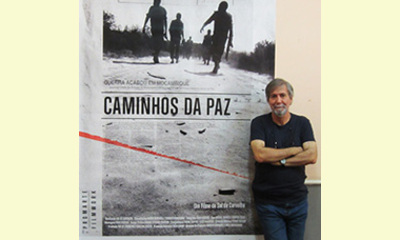|
|
WACC-SIGNIS Human Rights Award 2013 Goes to "Caminhos da paz" (Paths of Peace)
un article par SIGNIS, World Catholic Association for Communication
The 4th WACC-SIGNIS Human Rights Award 2013 has gone to the
documentary Caminhos da paz (Paths of Peace) directed by Sol de
Carvalho (Mozambique, 2013). A feature-length documentary, the
film highlights the successful role of the churches in the peace
process in Mozambique. [WACC = World Association for
Christian Communication] 
Sol de Carvalho presenting "Caminhos da paz" in Belgium
click on photo to enlarge
Caminhos da Paz covers a section of Mozambican history beginning
with the colonial war onto the civil war that followed. After
Mozambique achieved independence from Portugal in 1975, the
new Marxist-Leninist State run by FRELIMO (Frente de Libertação de
Moçambique) had to resist against Rhodesia and South Africa which
set up a movement for rebellion, RENAMO (Resistencia Nacional de
Moçambique). It developed in a bloody conflict and was turning the
country in ruins. The government wanted to negotiate peace, but
didn’t know who directed RENAMO or where they could be found.
Everything changed with the intervention of the Sant’Egidio
Community. From the beginning of the 1980s, this community had
given humanitarian aid to Mozambique and knew both sides.
FRELIMO began to soften its anti-religious stance and sought better
relations with the Protestant and Catholic Churches. Also the
Sant’Egidio Community was aware that the only real help would
come from reconciliation between the warring parties. It was they
who succeeded in contacting RENAMO to conduct the first
negotiations.
Caminhos da Paz recounts concerted efforts on the part of the
Roman Catholic and Protestant churches to bring about the peace
accords signed in Rome on 4 October 1992. It is one of the rare
examples in recent decades of a conflict resolved by negotiation in
Africa. According to Guido Convents of SIGNIS, "Sol de Carvalho has
made his documentary like a suspense thriller, with interviews with
all the protagonists and extracts from audiovisual archives.
Sometimes one wishes it would last longer! A real achievement and
a story full of emotion showing that hope exists."
The Mozambican Sol de Carvalho was born in 1953 and worked as a
journalist, editor and photographer. From 1985 on, he started to
work in cinema. Since then he has made many films, for the most
part documentaries and TV films and the feature film O Jardim do
Outro Homem (Another Man’s Garden). Sol de Carvalho’s work is
socially committed and often deals with taboo subjects like
HIV/Aids or domestic violence. Being a strong advocate for
participatory processes, he is often on the road in Mozambique
showing his films in villages and talking with the people.
|








|
DISCUSSION
Question(s) liée(s) à cet article:
What are some good films and videos that promote a culture of peace,
* * * * *
Commentaire le plus récent:
This discussion question applies to the following articles:
WACC-SIGNIS Human Rights Award 2013 Goes to "Caminhos da paz"
Edward Snowden Congratulates Laura Poitras for Winning Best Documentary Oscar for Citizenfour
Documentary Review: “Where to Invade Next” by Michael Moore
Snowden: Best Film of the Year
Film review: Disturbing the Peace
Film: Truth, Deception and the Spirit of I.F. Stone
For more recent articles and discussion, click here.

|
|









